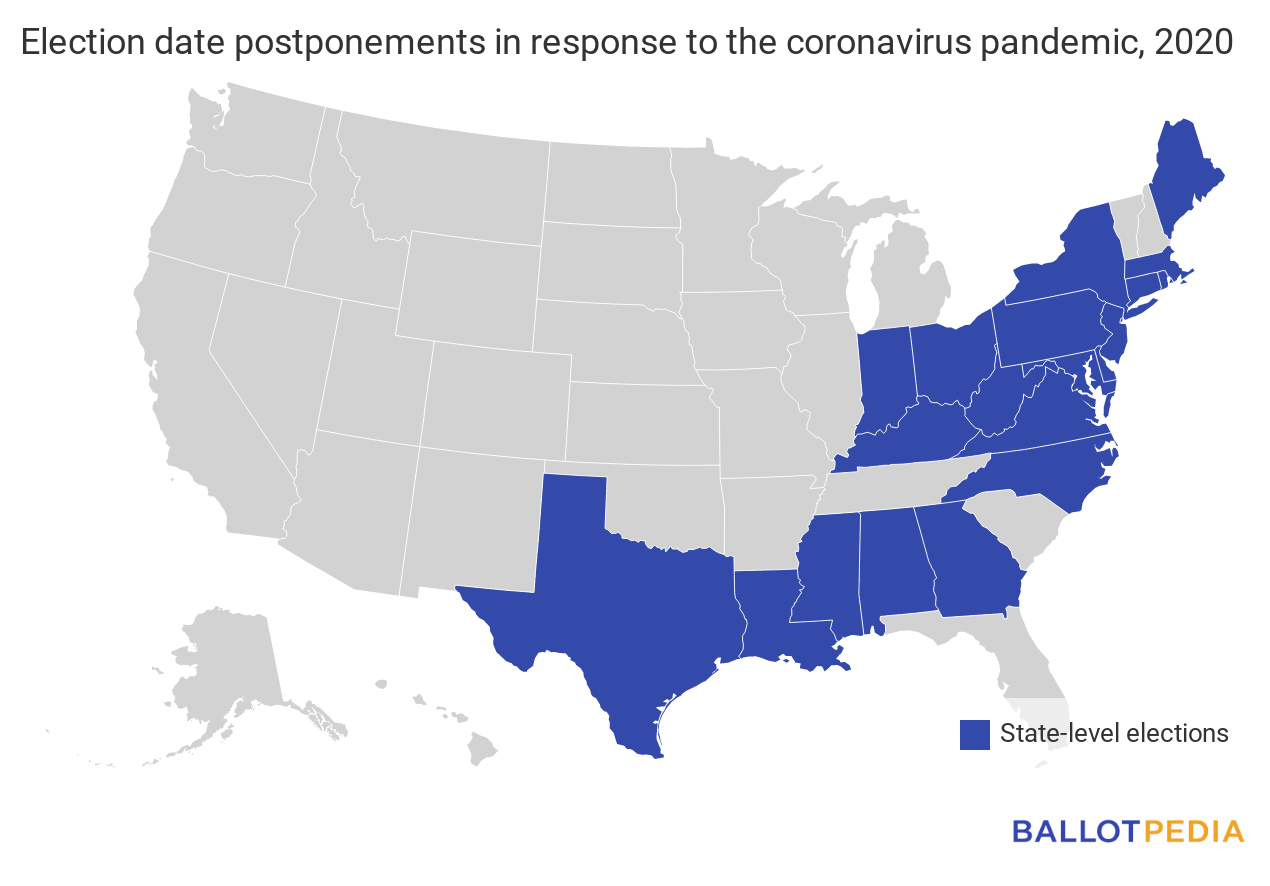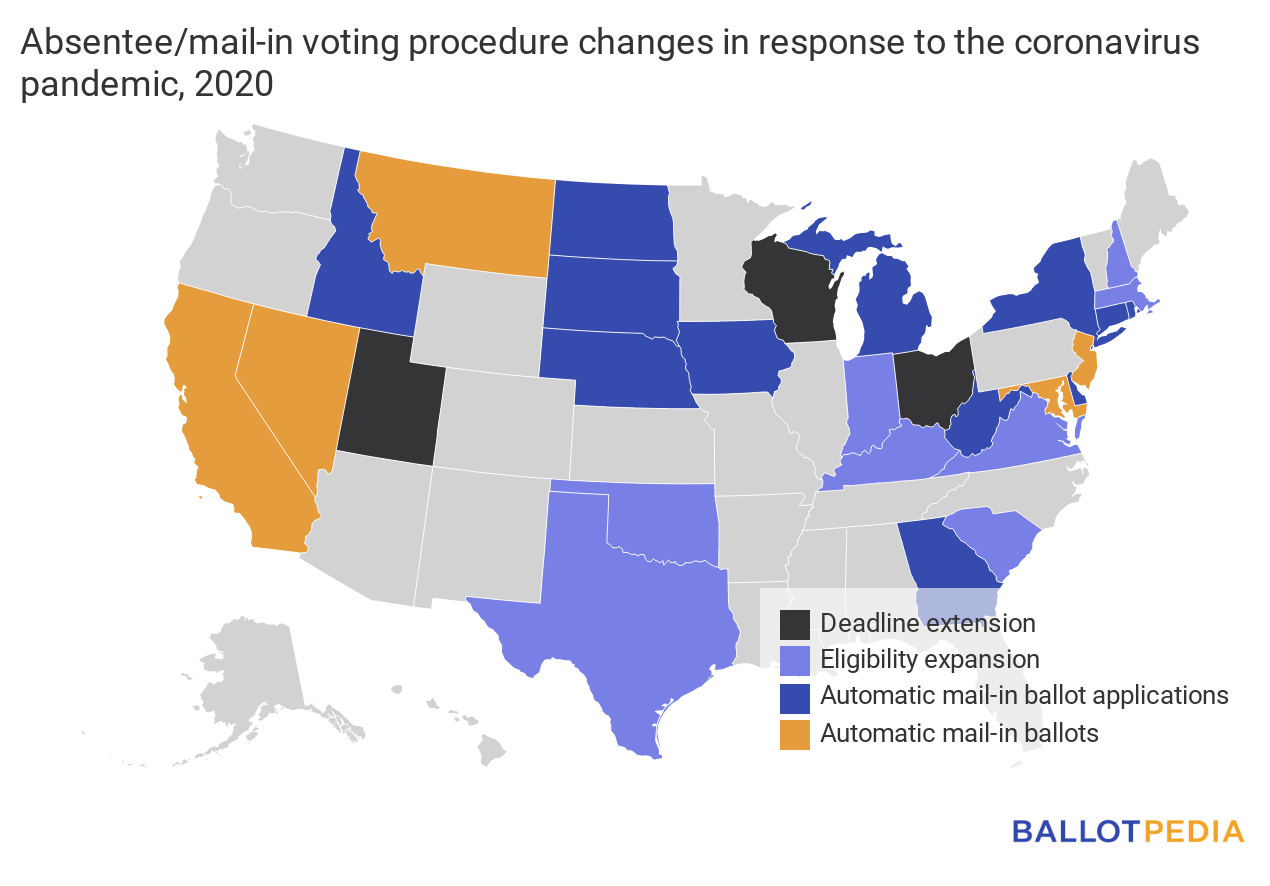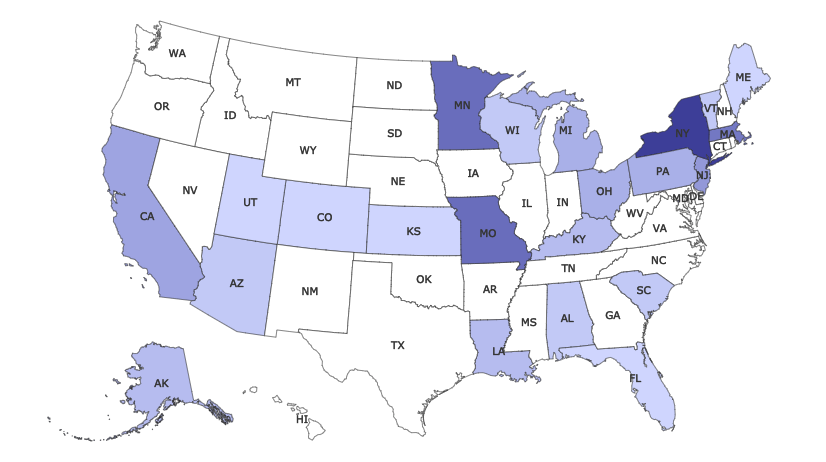Redistricting and the COVID-19 outbreak
The COVID-19 outbreak in the United States has prompted election postponements, alterations to absentee/mail-in voting policies, and adjustments to candidate filing protocols. The outbreak also stands to affect the redistricting cycle set to begin next year. This week, we turn our attention to this topic.
The 2020 census: why it matters
Article I, Section 2, of the United States Constitution requires that a census of the U.S. population be conducted every 10 years. Census results inform apportionment and redistricting efforts. The congressional and state legislative district maps drawn on the basis of 2020 census results will stand until after the next census in 2030 (although maps may be subject to court challenges).
Article I, Section 2, also stipulates that congressional seats be apportioned, or allotted, to the states on the basis of population. There are 435 seats in the United States House of Representatives. A state may gain or lose seats in the House if its population increases or decreases, relative to the other states. In 1964, the United States Supreme Court ruled in Wesberry v. Sanders that the populations of House districts must be equal “as nearly as practicable.”
The Constitution is silent on the issue of state legislative redistricting. In the mid-1960s, the Supreme Court issued a series of rulings establishing standards for state legislative redistricting. In Reynolds v. Sims, the court ruled that “the Equal Protection Clause [of the United States Constitution] demands no less than substantially equal state legislative representation for all citizens, of all places as well as of all races.”
COVID-19 and the 2020 census
The 2020 census, the nation’s 24th, is already underway. However, the COVID-19 outbreak may cause significant delays in the count.
The Census Bureau has requested that Congress approve a four-month delay in delivering redistricting data to the states. This would postpone the following key census events (original dates are italicized; proposed postponements are bolded):
- Process apportionment counts (July 31, 2020 – Dec. 31, 2020; Oct. 31, 2020 – April 30, 2021)
- Process redistricting data (January 1, 2021 – March 30, 2021; May 1, 2020 – July 31, 2021)
- Deliver apportionment counts to the president (Dec. 31, 2020; April 30, 2021)
- Deliver redistricting counts to the states (April 1, 2021; July 31, 2021)
These delays, in turn, would affect redistricting efforts set to begin next year:
- Two states – New Jersey and Virginia – are scheduled to conduct state legislative elections in 2021. In both states, primaries are scheduled for June 8, more than a month in advance of the Census Bureau’s proposed July 31 data delivery deadline.
- Three states – California, Delaware, and Maine – have fixed redistricting deadlines set to occur before the July 31 deadline. Another six states – Hawaii, New York, Ohio, South Dakota, Utah, and Washington – have fixed redistricting deadlines set to occur at some point after July 31.
- Nine states – Alabama, Arkansas, Illinois, Massachusetts, Nevada, New Hampshire, Oklahoma, Oregon, and Vermont – have census-contingent deadlines for state legislative redistricting. One state – Indiana – has a census-contingent deadline for congressional redistricting. Two states – Connecticut and Michigan – have census-contingent deadlines for both congressional and state legislative redistricting.
- Eleven states – Alaska, Colorado, Iowa, Louisiana, Minnesota, Missouri, Montana, North Carolina, Pennsylvania (legislative districts only), Texas, and Wisconsin – have redistricting deadlines tied to the receipt or publication of census data.
- Five states – Florida, Kansas, Maryland, Mississippi, and Wyoming – are not required to complete legislative redistricting until 2022. Two states – Mississippi and New Jersey – are not required to complete congressional redistricting until 2022.
- Eleven states do not have any statutory or constitutional state legislative redistricting deadlines. Twenty-eight states do not have statutory or constitutional congressional redistricting deadlines.
Redistricting ballot measures
We have tracked nine statewide redistricting ballot measures this year. These measures would, to varying extents, alter existing redistricting processes ahead of the coming redistricting cycle. Social distancing protocols implemented at the state and local levels have affected signature-gathering efforts for some of these measures. Here is a brief status update on each of these nine measures:
- Arizona State Legislative District Population Standards Amendment (2020): Pending (legislatively referred constitutional amendment; no petition signatures required).
- Arkansas Redistricting Commission Amendment (2020): Pending (initiated constitutional amendment; petition signatures required).
- Missouri Lobbying, Campaign Finance, and Redistricting Amendment (2020): On the ballot.
- Nebraska Redistricting Commission Initiative (2020): Pending (initiated constitutional amendment; petition signatures required).
- Nevada Independent Redistricting Commission Initiative (2020): Pending (initiated constitutional amendment; petition signatures required).
- North Dakota Top-Four Ranked-Choice Voting, Redistricting, and Election Process Changes Initiative (2020): Pending (initiated constitutional amendment; petition signatures required).
- Oklahoma State Question 810, Independent Redistricting Commission Initiative (2020): Pending (initiated constitutional amendment; petition signatures required).
- Oregon Independent State and Congressional Redistricting Commission Initiative (2020): Pending (initiated constitutional amendment; petition signatures required).
- Virginia Redistricting Commission Amendment (2020): On the ballot.
Election postponements
Since our May 6 edition, we’ve tracked the following election postponement updates:
- Delaware: On May 7, Gov. John Carney (D) announced the postponement of the state’s presidential primary to July 7. Carney also postponed school board elections to July 21.
- New York: On May 19, a three-judge panel of the U.S. Court of Appeals for the Second Circuit affirmed a lower court decision reinstating New York’s Democratic presidential preference primary on June 23.
To date, 20 states and one territory have postponed upcoming state-level elections. These states are shaded in dark blue on the map below.

Absentee/mail-in voting modifications
Since our May 6 edition, we’ve tracked the following absentee/mail-in voting modifications:
- California: On May 8, Gov. Gavin Newsom (D) signed an executive order directing county election officials to send mail-in ballots to all registered voters in the Nov. 3 general election.
- Delaware: On May 7, Gov. John Carney (D) announced that the state would automatically mail absentee ballot applications to all eligible voters in the presidential preference primary.
- Michigan: On May 19, Secretary of State Jocelyn Benson (D) announced that all registered voters in the Aug. 2 primary and Nov. 3 general election would automatically receive mail-in ballot applications.
- New Jersey: On May 15, Gov. Phil Murphy (D) issued an executive order providing for expanded mail-in voting in the July 7 elections. All registered, active Democratic and Republican voters will automatically receive mail-in ballots. Unaffiliated and inactive voters will automatically receive mail-in ballot applications.
- Oklahoma: On May 7, Gov. Kevin Stitt (R) signed SB210 into law, reinstating the absentee ballot notarization requirement struck down by the state supreme court on May 4. The legislation also included provisions applicable only to the 2020 election cycle, including absentee voting eligibility expansions and a modified verification requirement for those unable to have their absentee ballots notarized.
- South Carolina: On May 13, Gov. Henry McMaster (R) signed into law a bill allowing any eligible South Carolina voter to request an absentee ballot for the state’s June 9 primary and subsequent runoff elections.
To date, 28 states have modified their absentee/mail-in voting procedures. These modifications can be divided into five broad categories:
- Automatic mail-in ballots: Five states (California, Maryland, Montana, Nevada, and New Jersey) have opted to send mail-in ballots automatically to all eligible voters in advance of certain elections to ensure that most voting takes place by mail. These states are shaded in yellow in the map below.
- Automatic mail-in ballot applications: Twelve states (Connecticut, Delaware, Georgia, Idaho, Iowa, Michigan, Nebraska, New York, North Dakota, Rhode Island, South Dakota, and West Virginia) are automatically sending mail-in ballot applications to all eligible voters in advance of certain elections. These states are shaded in dark blue in the map below.
- Eligibility expansions: Eight states (Indiana, Kentucky, Massachusetts, New Hampshire, Oklahoma, South Carolina, Texas, and Virginia) have expanded absentee voting eligibility in certain elections. These states are shaded in light blue in the map below.
- Deadline extensions: Three states (Ohio, Utah, and Wisconsin) have extended absentee/mail-in ballot request or submission deadlines in certain elections. These states are shaded in dark gray in the map below.

Legislation tracking
To date, we have tracked 118 bills that make some mention of both election policy and COVID-19. States with higher numbers of relevant bills are shaded in darker blue on the map below. States with lower numbers of relevant bills are shaded in lighter blue. In states shaded in white, we have tracked no relevant bills.
Legislation related to elections and COVID-19, 2020
Current as of May 19, 2020
 Looking ahead
Looking ahead
We are tracking 60 lawsuits in 26 states involving pandemic-related election issues. In our next issue, we will turn our attention to these lawsuits, examining in greater detail some of the more noteworthy suits that have been filed in recent weeks.

